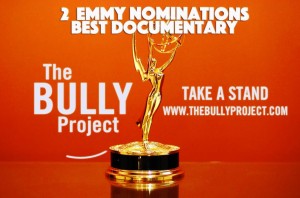Tale of Two Documentaries
By Cindy Waitt and Dr. Alan Heisterkamp
See the piece from Huffington Post
http://www.huffingtonpost.com/cindy-waitt/tale-of-two-documentaries_b_8153700.html
“It was the best of times, it was the worst of times.” Charles Dickens, Tale of Two Cities
On September 28th, we’ll be attending the 36th Annual News and Documentary Emmy Awards in honor of two very different films that we supported from their inception, “Bully” and “Private Violence”.
“Bully” opened the PBS Independent Lens season and “Private Violence’ bowed on HBO, both in October of 2014. As early supporters of both, we at Waitt Institute for Violence Prevention couldn’t have been happier about that. But their road to the finish line couldn’t have been more different.
Lee Hirsch and Cynthia Lowen’s “Bully” had the “buzz’ from the beginning. It struck a powerful chord, in its riveting and authentic footage of children and families devastated by bullying. Kids tormenting kids hits us at a basic level, and it’s a powerful punch. It was a perfect meshing of the right time, right place, and right issue
“Private Violence” was a very different story. Cynthia Hill’s direction, Kit Gruelle’s voice and vision throughout, and Deanna Walters’ frightening and extraordinary journey weaves the experiences of domestic abuse survivors and advocates, as it challenges, and consequently explodes the myths behind domestic violence. It suggests some answers to the age old question, “Why doesn’t she just leave’?
While both documentaries were driven by the same hopes, concerns, and passions, the production and postproduction of “Bully” took about two years to fund. “Private Violence” was started more than eight years ago.
We think it’s time to move past the national disconnect and acknowledge how intertwined these two issues are. As early backers of both films, we believe that violence in the home and bullying in school must be treated as co-equals. They are inextricably linked, and the data backs it up. A 2011 CDC study told us that kids who witness violence in the home are more likely to be bullied, and more likely to become bullies themselves. http://www.cdc.gov/mmwr/preview/mmwrhtml/mm6015a1.htm
It’s time to see that the first time some children see or witness violence is not in the school yard. It’s where they live. Over 8 million children were exposed to family violence in the last year alone.
As we advocate that prevention should start with kids, let’s not forget that bullying prevention education can be paired with the critical piece of age appropriate relationship violence awareness programs and can change the attitudes and behavior of young people as they enter adulthood.
Research now looks at possible links between bullying and dating violence. Prevent
Connect cites the following, “Young adolescents who perpetrate bullying become involved in romantic relationships earlier than those who do not bully, and are more likely to report verbal and physical aggression in their earliest intimate relationships” (Josephson and Pepler, 2012)
Bullying is universal and non- gender specific. Who doesn’t relate to being bullied at some time in their life? Family First Aid reports that about 30 percent of teenagers in the U.S. have been involved in bullying, either as a bully or as a victim and we’ve all seen it, either as a victim, a perpetrator, or a witness. That’s a frightening number. Too many children are a part of this.
However, according to partners at Futures without Violence, “approximately one in three adolescent girls in the United States is a victim of physical, emotional or verbal abuse from a dating partner – a figure that mirrors victimization rates for other types of violence affecting youth.” http://www.futureswithoutviolence.org/resources-events/get-the-facts/
Gloria Steinem, an early supporter and Executive Producer of “Private Violence”, has suggested that the term “domestic violence” should be changed to “original violence. “ It’s what makes people feel that it’s inevitable or that it’s normal or both”, she said. “If you have violence in the home then it normalizes it everywhere else.”
Dickens’ quote “it was the best of times, it was the worst of times” could describe what we, in the violence prevention movement, feel today. As many strides as we’ve made, we still have a long way to go. Linking violence in its many forms and helping kids, educators, and families connect those dots is vital. As a Futures Without Violence ad campaign suggested, “Teach them early, teach them often.” With dating violence and bullying prevention, teach them together.



Leave a Reply